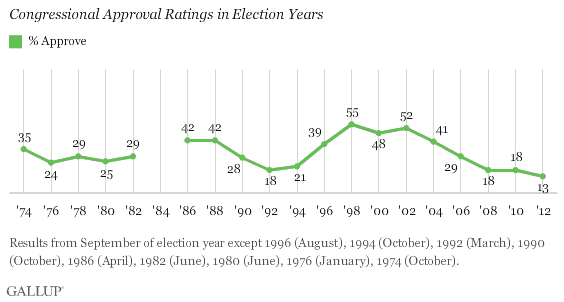PRINCETON, NJ -- Thirteen percent of Americans approve of the job Congress is doing, the lowest Gallup has measured this late in an election year. The prior lows were 18% in 1992, 2008, and 2010.

In election years in which congressional approval has been low in the months leading up to Election Day, there has generally been higher turnover of seats in Congress. Another factor that may promote higher turnover in this year's congressional elections is the redistricting of all 435 seats after the 2010 census. In 1992, a year in which Congress was unpopular and incumbents seeking re-election were running in newly redrawn districts, more than 100 new members of Congress were elected. That compares with 53 new members after the 2002 elections, the last elections that followed redistricting, but a time when Congress was much more popular.
Congress has never had very high approval ratings at this point in an election year; only twice since 1974 were they over 50% -- in 1998, during the economic boom, and in 2002, during the rally in support for public officials after the Sept. 11 terrorist attacks. The historical average approval rating for Congress is 33%.
Given the recent trend, it is unlikely that Congress' approval rating will get much higher in Gallup's October reading, the final one before the elections. Though Congress' approval rating today is slightly better than in August, Gallup has measured larger increases since then in President Obama's approval rating and Americans' satisfaction with the way things are going.
Less than 20% of Americans have approved of Congress each month since June 2011, including record-low 10% readings in February and August.

One reason Congress' ratings may be depressed is the split party control of the institution, with Republicans holding a majority in the House of Representatives and Democrats having a majority in the Senate. Currently, 16% of Democrats, 12% of independents, and 10% of Republicans approve of the job Congress is doing.
If one party controlled both houses of Congress, that party's rank-and-file supporters would likely look more favorably on Congress, and push its overall ratings higher. This was the case for the prior Congress, which, although unpopular, was looked more highly upon by Democrats than Republicans given Democratic control of the institution from 2009-2010.
Implications
In less than two months, all U.S. House seats and roughly one-third of U.S. Senate seats will be decided in the elections. Though overshadowed by the presidential race, the results of the congressional elections will have a major effect on the way the country is governed over the next two years -- in terms of whether one party can gain control of both houses of Congress and whether the president will have a Congress controlled by his own party or the opposition party.
Given Congress' near-record-low job approval ratings, voters may continue to take out their frustrations on members of the institution, which has resulted in considerable turnover in congressional membership or party composition in each of the last three election years.
Survey Methods
Results for this Gallup poll are based on telephone interviews conducted Sept. 6-9, 2012, with a random sample of 1,017 adults, aged 18 and older, living in all 50 U.S. states and the District of Columbia.
For results based on the total sample of national adults, one can say with 95% confidence that the maximum margin of sampling error is ±4 percentage points.
Interviews are conducted with respondents on landline telephones and cellular phones, with interviews conducted in Spanish for respondents who are primarily Spanish-speaking. Each sample includes a minimum quota of 400 cell phone respondents and 600 landline respondents per 1,000 national adults, with additional minimum quotas among landline respondents by region. Landline telephone numbers are chosen at random among listed telephone numbers. Cell phone numbers are selected using random-digit-dial methods. Landline respondents are chosen at random within each household on the basis of which member had the most recent birthday.
Samples are weighted by gender, age, race, Hispanic ethnicity, education, region, adults in the household, and phone status (cell phone only/landline only/both, cell phone mostly, and having an unlisted landline number). Demographic weighting targets are based on the March 2011 Current Population Survey figures for the aged 18 and older non-institutionalized population living in U.S. telephone households. All reported margins of sampling error include the computed design effects for weighting and sample design.
In addition to sampling error, question wording and practical difficulties in conducting surveys can introduce error or bias into the findings of public opinion polls.
View methodology, full question results, and trend data.
For more details on Gallup's polling methodology, visit www.gallup.com.
